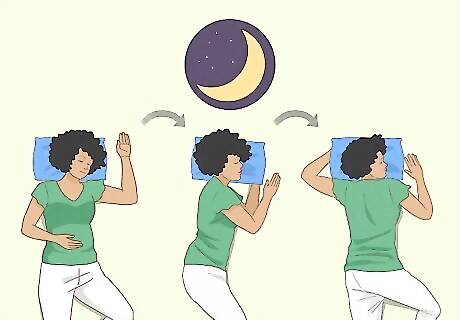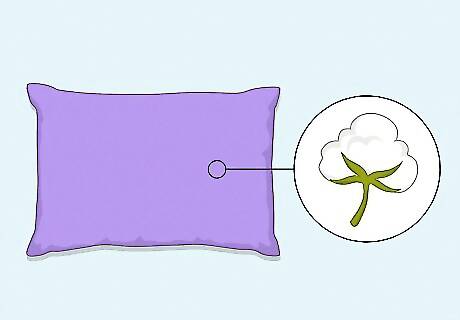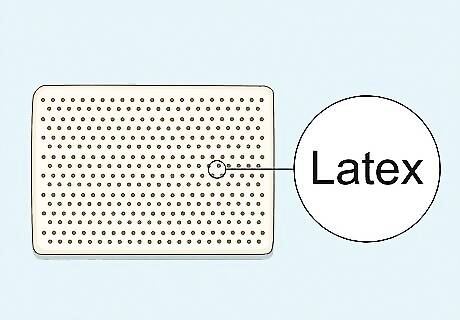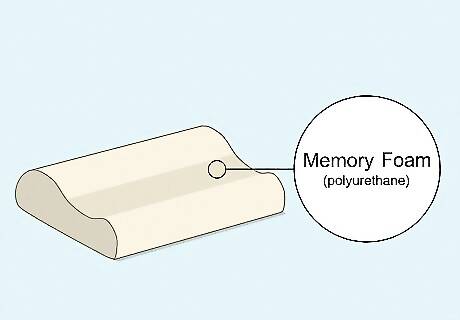
views
X
Research source
Taking time to determine what the best pillow is for you based on your sleeping habits and personal needs will help ensure that you wake up refreshed and ready for your day.
Confirm your sleeping position.

Pick a pillow based on your sleeping position. When you are getting ready to fall asleep, spend a few minutes on your back, on your side, and on your stomach. See which one feels the most comfortable for you. If you spend half an hour on your stomach and you haven’t fallen asleep, it’s probably not your preferred position. If you are a stomach sleeper, you will need a soft, fairly flat pillow, or you may not need any pillow at all. Having a soft pillow will allow your neck to stay more in line with your spine. If you are a back sleeper, look for a medium thick pillow. You don’t want it to be too thick, or it will push your head too far forward. You also don’t want it to be too soft, or your head will simply sink down to the mattress. In this case, you may want a pillow which is thicker and firmer on the bottom, to provide a bit of neck support. Side sleepers will need a thicker, firmer pillow to help support the neck. If you find that you are a mixed sleeper and you find many positions comfortable throughout the night, look for a pillow that is of medium thickness, and a bit softer so that it can be used comfortably in different positions If you tend to snore, sleeping on your side is much better. You’re more likely to snore if you sleep on your back.
Choose a down or feather pillow if you want something long-lasting.

Pick a natural material because down pillows can last 10 years. Plus, they are resilient and breathable because they are made of a natural material. Just keep in mind that down pillows are very light and soft, while feather pillows tend to be on the harder side. These pillows are typically made from the inner plumage of geese or ducks. They can be filled according to your preferences. Although there is no scientific evidence that down or feather pillows exacerbate allergies or asthma, some people prefer to avoid them. You might wish to avoid down/feather pillows for ethical reasons, or due to asthma or allergies. In this case, there are synthetic versions available.
Pick a cotton or wool pillow if you have allergies.

These pillows aren’t susceptible to dust mites or mold. Just be aware that these pillows tend to be quite firm, so they may not be the most suitable for stomach sleepers. If you are a stomach sleeper, but you also want a pillow that is hypoallergenic, you may be able to find a very thin wool or cotton pillow.
Select a latex pillow as another allergy-friendly choice.

These pillows are also mold-resistant, making them good for allergy sufferers. They’re made from the sap of rubber trees, making it elastic and resilient. Plus, they come in a variety of shapes, sizes, and consistencies. These pillows are good for allergy sufferers, as they are mold resistant. They tend to be cooler than memory foam and can form to fit your head and neck. They do not offer as much ‘give’ as a memory foam pillow and can be quite heavy, and expensive.
Choose a memory foam pillow for a form-fitting option.

They provide good support, especially if you have neck, jaw, or shoulder problems. Memory foam pillows are made of polyurethane, which is then mixed with additional chemicals. Plus, they last a long time and come in a lot of different shapes and sizes. High density is best in order to avoid the material breaking down. Be aware that this material can make you hot, as it doesn't "breathe." If you tend to move around a lot, these pillows may be uncomfortable since they take a bit of time to mold into different shapes. A new memory foam pillow may have an unpleasant odor which will go away after a short while.
Pick a specialty pillow to meet your specific needs.

A "normal" pillow may not be your best choice if you have certain sleeping habits or health conditions. However, be aware that while a specialty pillow might be helpful for you, there is not much research to back up claims the manufacturer might make, and they can be quite expensive. A positional pillow is a lower case n-shaped pillow that claims to help those with sleep apnea stay in the ideal position. The pillow also claims to help reduce tossing and turning throughout the night. Cervical pillows provide extra firmness in the lower part of the pillow in order to provide support for the neck. The claim is that these pillows will help reduce neck tension and headaches, however, there has not been sufficient research to back up this claim. Anti-snore pillows claim to help position the head so that the airways remain open by lifting the chin away from the chest. They aren’t particularly helpful when it comes to snoring, but you can certainly use one of these if you find them comfortable. Cool pillows are designed to include fillings that absorb head heat in order to keep you feeling cool. Although they can be used by anyone who wishes to keep cool at night, they may be particularly suitable for someone suffering from hot flashes. Oxygen pillows are designed to promote the circulation of air, which is meant to help you breathe more freely and deeply while you sleep. While some claim this has helped relieve pain, doctors are not sure how or whether or not this technology actually works.
Read reviews online before going shopping.

Make sure that pillow lives up to its claims. This is especially important if you want to buy a special pillow, such as an anti-snoring or cooling pillow. These can be on the expensive side, so you want to be sure you’re getting your money’s worth! Remember–price isn’t everything. The best pillow for you may not be the most expensive one. Try out different pillows in different price ranges.
Try out the pillow before buying it.

Many stores that sell pillows also sell mattresses, and may let you test the pillow. If you can, take the pillow and lie down with it for a few minutes to try it out. This will give you a more realistic idea of whether the pillow is right for you or not. If you are unable to lie down with a pillow, try standing next to a wall in your favorite sleeping position. Place the pillow against the wall. If the pillow you are testing works with your body, your neck should be aligned with your spine. It may be difficult to tell on your own if your neck is not aligned, so bring a friend along to help you.
Ask about trial periods and money back guarantees.

Some stores let you return your pillow if you are not happy with it. Before purchasing a pillow, ask about the return policy.



















Comments
0 comment